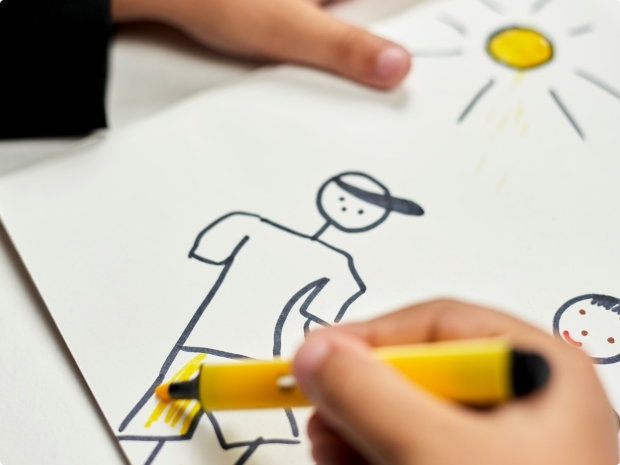Creativity and Literacy
We believe that creativity is not only important to children’s literacy, but is in fact an inseparable part of language acquisition and production.

Creativity Through Language
Do you think language is just a communicative tool? Do we just passively use language? Or can we create it?
Creativity can be simply described as the ability to see ordinary things differently or an incremental change to something that already exists. Creative skills are important across many disciplines, including the working environment and various life situations. Creative thinking helps us to see alternatives, solve problems more easily, and think in a more independent way.
Although it is very important, however, creativity is not an area often addressed in language teaching. Teaching languages in a way that enhances creative thinking can facilitate these abilities to develop. That is why Bumper Cards™ helps. With Bumper Cards™, children’s creativity is encouraged: Children are not only asked to create real, everyday words, but also novel ones. Thus, the game stimulates both convergent thinking (regular learning) and divergent thinking (thinking of multiple solutions for a problem). Throughout the process, children’s language skills are also encouraged, in either one language or two, so they will be more likely to express themselves more flexibly and creatively.
Traditional methods of teaching language might not think highly of encouraging children to come up with what seem like “silly” answers, even with good explanations. This is highly praised and stressed in playing our Bumper Cards™ game. One plus one does not always equal 2. Language is flexible and creative! Creativity is not for geniuses only; all kids can be creative if they are given enough opportunities. Parents usually think that creativity refers to the abilities to create artworks or pictures. And creativity in language simply means giving good speeches or writing good essays. This is not true. Imagination or creative thinking is enhanced through drawing and creating words. It is not necessary to wait until kids acquire a certain level of language or literacy to encourage them to be creative. This can be initiated in a fun way much earlier with our Bumper Cards™ game!
It is understandable that some of you may not feel comfortable with encouraging children to create novel words or vocabulary concepts if you don’t have the background knowledge in literacy learning. Don’t worry! Creating novel words is absolutely a manifestation of creativity! You should be proud of that. Moreover, many influential studies in Chinese (e.g., McBride-Chang, Shu, Zhou, Wat, & Wagner, 2003; Shu, McBride-Chang, Wu, & Liu, 2006; Zhang, McBride-Chang, Tong, et al., 2012) and other languages (e.g., Kim, Guo, Liu, Peng, & Yang, 2019; Zhang, Lin, Wei, & Anderson, 2014) consistently demonstrate that children who have greater abilities to create novel words perform better in word reading, vocabulary knowledge, and reading comprehension. So, start embracing creativity using Bumper Cards™ with your kids today!
Reference
Kim, Y. G., Guo, Q., Liu, Y., Peng, Y., & Yang, L. (2019). Multiple Pathways by Which Compounding Morphological Awareness Is Related to Reading Comprehension: Evidence From Chinese Second Graders. Reading Research Quarterly. https://doi.org/10.1002/rrq.262
McBride-Chang, C., Shu, H., Zhou, A., Wat, C. P., & Wagner, R. K. (2003). Morphological Awareness Uniquely Predicts Young Children’s Chinese Character Recognition. Journal of Educational Psychology, 95(4), 743–751. https://doi.org/10.1037/0022-0663.95.4.743
Shu, H., McBride-Chang, C., Wu, S., & Liu, H. (2006). Understanding Chinese developmental dyslexia: Morphological awareness as a core cognitive construct. Journal of Educational Psychology, 98(1), 122–133. https://doi.org/10.1037/0022-0663.98.1.122
Zhang, J., Lin, T. J., Wei, J., & Anderson, R. C. (2014). Morphological Awareness and Learning to Read Chinese and English (pp. 3–22). https://doi.org/10.1007/978-94-007-7380-6_1
Zhang, J., McBride-Chang, C., Tong, X., Wong, A. M. Y., Shu, H., & Fong, C. Y. C. (2012). Reading with meaning: The contributions of meaning-related variables at the word and subword levels to early Chinese reading comprehension. Reading and Writing, 25(9), 2183–2203. https://doi.org/10.1007/s11145-011-9353-4
How to Play?
Creativity through language: Bumper Cards ™ Card Game is a fun and easy-to-play card-game designed for children aged 3 to 8, based on more than 20 years of research on reading and vocabulary development.
- About Bumper Cards™ card game
- How to play Bumper Cards™ card game?
- Ways of Learning


Why is creativity so important?
With creativity comes new possibilities, new ways of seeing the world. Creativity leads to new inventions, new discoveries, new artistic creations. In school, children are often taught that there is one right answer to every problem. Such learning, termed convergent thinking, is important for mastering new materials and disciplines such as chemistry, algebra, or how to write Chinese characters correctly. At the same time, however, encouraging children (and adults!) to generate new ideas, sometimes termed divergent thinking, is the key to generating new solutions for the future.
Related Research Findings

How creativity facilitates bilingual language learning?
We constantly generate new expressions using our native language. As we learn new languages, we are also flexible and generate new ideas. Some of these are correct, and some of these are actually the wrong form. That's o.k. Moreover, there are some rules in one language that are less prominent or absent in another. Most important, we cannot learn a language without making some mistakes and learning from them. Early language learners should strive first to communicate and to make use of all the new words encountered. Later in the language process, language learners become more focused on the correct forms of each word and expression. Yet early on, we must use language flexibility. We also make connections between languages and start to understand in what ways our native and later learned languages are the same and how they are different by using them. As we engage in this process, we are creative. Creativity implies flexibility and curiosity in learning language. Such curiosity and flexibility is motivating for optimal language learning. In this way, creativity facilitates biilngual learning.
Related Research Findings

Why is it important to learn with games?
How do we keep ourselves and our children on track to continue learning? When learning is rewarding, we are more likely to persist in learning. Games are a great way to get children to learn more and to learn more quickly. With games, children make connections more quickly because they enjoy the process. Using our Bumper Cards game also means that children are interacting with one another. They are talking more. They are speaking to one another and to parents and teachers. This act of discussion and active participation itself helps children to learn more by using their knowledge to express themselves. Games are challenging and systematic, inspiring children with goals and new ways to think about old concepts. With Bumper Cards, we are also encouraging children to come up with new concepts and ideas by combining words together. This is very challenging and demands a good understanding of words and how they fit together in a language. Learning through play is one of the best ways to generate both knowledge and enthusiasm for learning.
Related Research Findings

Bilingual Learning always be one of our focuses
Children who know more than one language often outperform monolingual children in acquiring critical learning skills such as attention, control, and reasoning. Longitudinal studies show that students in bilingual education programs not only catch up to their peers using only one language, but often outperform them with time. In addition, many reading skills and performance are transferable across languages, and bilingual children can develop strong reading and writing skills easily in both languages.
